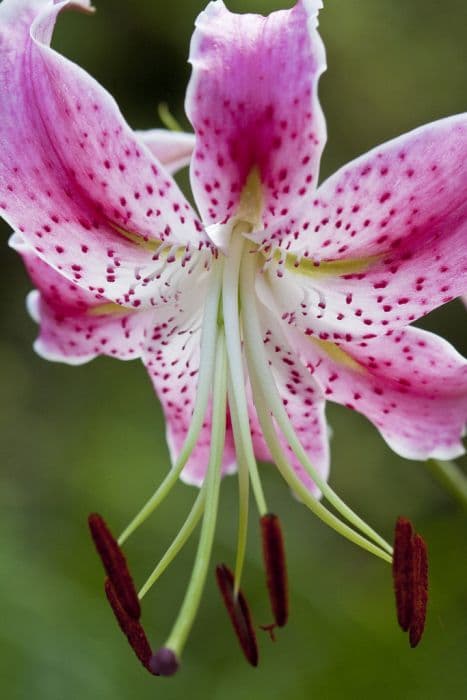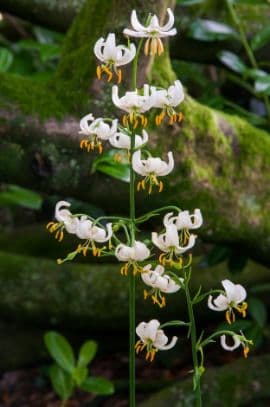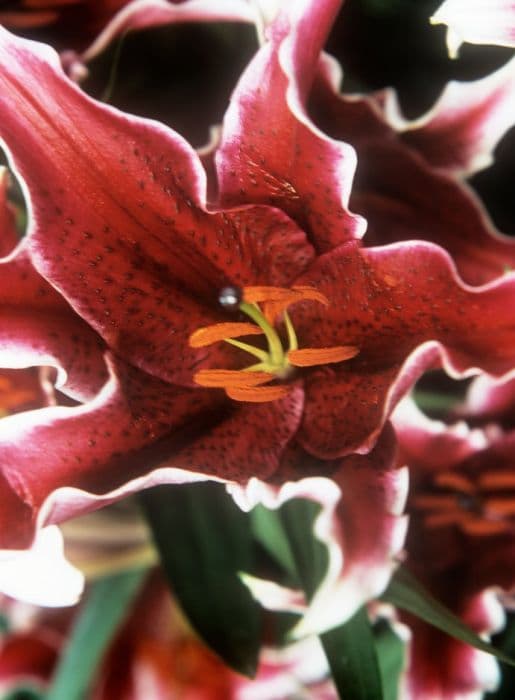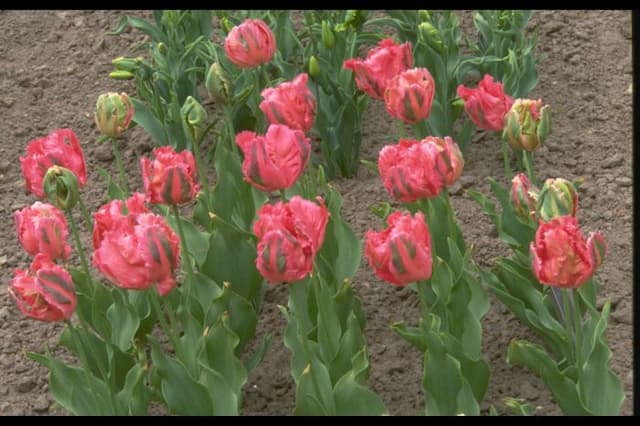Japanese lily Lilium speciosum (Ixb-c/d)

ABOUT
Lilium speciosum, commonly known as the Japanese lily, is a stunning flowering plant that exhibits remarkable beauty. This lily has large, outward-facing flowers that can have a variety of colors, typically featuring a base of pink with darker spots, although coloration can vary widely from plant to plant. The petals are often recurved, which means they curve backward, adding to the distinctive look of the bloom. Each petal is adorned with prominent spots, and the tips are ruffled or fringed, which contributes to its ornate appearance. The stamens of the Japanese lily are long and protrude from the center of the flowers, bearing anthers at the tips that contain the pollen. The contrast of the dark anthers against the lighter petals further accentuates the flower's beauty. Besides the striking flowers, this lily has dark green, glossy leaves that grow along the length of the stem in a spiral pattern, which adds to its overall lush appearance. The leaves provide a visually pleasing background that highlights the flowers when they are in bloom. The blooming season for the Japanese lily fills the surrounding space with its strong and sweet fragrance, which is especially potent during the evening and at night. This pleasant aroma, coupled with the visual appeal of the prominent blooms, makes it a favorite amongst gardeners and a frequent addition to ornamental gardens. Despite the omission of specifics regarding its size, the general appearance of the Japanese lily is unquestionably striking and makes it a sought-after species for its aesthetic qualities.
About this plant
 Names
NamesFamily
Liliaceae
Synonyms
Japanese Lily, Showy Lily, Speciosum Lily
Common names
Lilium speciosum var. gloriosoides Baker, Lilium gloriosoides (Baker) Wilson.
 Toxicity
ToxicityTo humans
The plant commonly known as Japanese Lily (Lilium speciosum) has parts that can be toxic to humans if ingested. However, toxicity is generally low and it is rare for serious complications to occur in humans. If someone does consume parts of a Japanese Lily, they may experience symptoms such as nausea, vomiting, and diarrhea. These symptoms are often the body's response to trying to eliminate the ingested toxin. It's important to be cautious and prevent ingestion, especially in children who might be tempted by the colorful flowers.
To pets
The Japanese Lily (Lilium speciosum) is extremely toxic to cats and can cause severe kidney damage if ingested. Even small amounts of any part of the plant, including the pollen, leaves, or flowers, can be dangerous. Symptoms of lily poisoning in cats may include vomiting, lethargy, lack of appetite, kidney failure, and, without prompt and proper treatment, can be fatal. Dogs are less sensitive to lilies but may still experience mild digestive upset if they consume parts of the plant. Any pet suspected of eating a Japanese Lily should receive veterinary attention immediately.
 Characteristics
CharacteristicsLife cycle
Perennials
Foliage type
Deciduous
Color of leaves
Green
Flower color
Pink
Height
3-4 feet (0.9-1.2 meters)
Spread
1 foot (0.3 meters)
Plant type
Bulb
Hardiness zones
5
Native area
Japan
Benefits
 General Benefits
General Benefits- Aesthetic Appeal: Lilium speciosum, commonly known as the Japanese lily, adds beauty to gardens with its large, showy flowers that come in various colors including pinks, whites, and reds.
- Pollinator Attraction: The Japanese lily's bright, scented flowers attract bees, butterflies, and other pollinating insects, which is vital for the propagation of many plants and the health of local ecosystems.
- Cut Flower Use: With their long stems and lasting blooms, Japanese lilies are popularly used as cut flowers for arrangements and bouquets, enhancing interior decor with their elegance.
- Garden Design: They are often used in perennial borders, mixed beds, and as focal points due to their height and striking flowers, offering vertical interest in landscape design.
- Cultural Significance: The Japanese lily holds cultural importance in various regions, appreciated for its beauty and often used in festivals and celebrations.
- Biodiversity Support: By providing habitat and food for insects, the Japanese lily plays a role in maintaining biodiversity within its native range and in gardens where it is planted.
 Medical Properties
Medical Properties- Anti-inflammatory: Compounds found in Lilium speciosum, such as saponins, might reduce inflammation.
- Antitumor: Certain extracts of the plant have been studied for their potential antitumor properties.
- Antimicrobial: Some studies suggest that Lilium speciosum may have antimicrobial effects against certain pathogens.
- Antioxidant: The presence of phenolic compounds in the plant may contribute to its antioxidant effects.
 Air-purifying Qualities
Air-purifying QualitiesThis plant is not specifically known for air purifying qualities.
 Other Uses
Other Uses- Lilium speciosum, commonly known as Japanese lily, can be used as a natural dye; the petals contain pigments that can produce delicate colors on fabrics.
- The crushed bulbs of Japanese lily have been traditionally used as a starch substitute for ironing clothes, giving fabrics a smooth finish.
- This plant's sturdy stems can be utilized in lightweight garden constructions or as natural stakes for supporting other plants.
- The scent of Japanese lily flowers can be infused into oils or candles to create a naturally fragrant environment in homes or workplaces.
- The pollen from Japanese lily can be harvested and used for colorant in artisanal cosmetics, such as blush or eyeshadow.
- During several festivals in Asia, the petals of Japanese lily may be floated in water bowls as a decorative and fragrant centerpiece.
- The dried and ground bulb of Japanese lily is occasionally used in traditional papermaking to create a distinct texture.
- In floral art, the striking appearance of Japanese lily can be pressed and used in the creation of botanical prints or herbarium collections.
- Due to their significant size and shape, fallen Japanese lily petals can be used as natural confetti for outdoor celebrations and ceremonies.
- The sap from Japanese lily is sometimes used in natural glue recipes for bookbinding or repairing delicate papers.
Interesting Facts
 Feng Shui
Feng ShuiThe plant commonly known as Japanese lily is not used in Feng Shui practice.
 Zodiac Sign Compitability
Zodiac Sign CompitabilityThe Japanese lily is not used in astrology practice.
 Plant Symbolism
Plant Symbolism- Purity: In many cultures, lilies are symbols of purity and virtue, often associated with the Virgin Mary in Christian symbolism.
- Renewal: The blooming of lilies, particularly in spring, signifies rebirth and renewal, reflecting the cycle of life.
- Motherhood: Due to their association with the goddess Hera in Greek mythology, lilies can represent motherhood and fertility.
- Passion: While white lilies typically symbolize purity, the more vibrant hues, such as those of Lilium speciosum, can suggest a sense of passion and intensity.
- Beauty: The striking appearance of Lilium speciosum, also known as the Japanese lily, evokes feelings of admiration for its natural beauty and elegance.
 Water
WaterJapanese Lily requires regular watering, ensuring the soil remains moist but not waterlogged. During active growth in the spring and summer, water the plant thoroughly once a week, using about one gallon of water per session for an average-sized plant. Increase the frequency to twice a week in extreme heat but cut back to every other week when the plant is dormant in the fall and winter. Always allow the top inch of soil to dry out before watering again to prevent over-watering and root rot.
 Light
LightJapanese Lily thrives in partial shade with bright, indirect sunlight. The best spot would shield the plant from the harsh afternoon sun while providing ample light in the morning or late afternoon. An east- or north-facing location is typically ideal to meet these conditions, fostering healthy growth without scorching the leaves.
 Temperature
TemperatureJapanese Lily prefers temperate conditions and will flourish in temperatures ranging from 60 to 70 degrees Fahrenheit. It can tolerate a minimum temperature of about 40 degrees Fahrenheit but should be protected from freezing temperatures. The ideal environment would be a consistently cool to moderate area, away from drafty windows and heating vents that may cause fluctuations in temperature.
 Pruning
PruningPrune Japanese Lily after blooming has ceased to remove spent flowers and any yellowing leaves, which helps to encourage future blooms and maintain a tidy appearance. The best time to prune is in the late fall when the plant enters dormancy. Pruning once a year is generally sufficient as it prevents overcrowding and allows for better air circulation among the leaves.
 Cleaning
CleaningAs needed
 Soil
SoilThe Showy Lily thrives in well-draining, slightly acidic to neutral soil with a pH of 5.5 to 7. A mix containing loam, peat moss, and perlite or sand can provide the structure and drainage needed.
 Repotting
RepottingShowy Lilies should generally be repotted every 2 to 3 years to ensure they have enough space to grow and to refresh the soil, as it may become compacted over time.
 Humidity & Misting
Humidity & MistingLilies like Showy Lily prefer moderate humidity levels, ideally between 40-60%, to mimic their natural growing conditions and support their overall health.
 Suitable locations
Suitable locationsIndoor
Place in bright, indirect light, ensure good air circulation for Showy Lily.
Outdoor
Plant in well-drained soil, part-shade to full sun for Showy Lily.
Hardiness zone
4-9 USDA
 Life cycle
Life cycleThe life of Lilium speciosum, commonly known as the Japanese lily, begins with a seed, which upon germination in spring, develops into a bulb. This bulb will then give rise to a stem, leaves, and roots as it matures. Throughout the growing season, the stem elongates, and leaves develop along the stem, photosynthesizing to provide energy for growth. By mid to late summer, the Japanese lily will produce captivating flowers that are often fragrant and come in shades of pink, red, or white with speckles. After pollination by insects, the flowers will produce seed capsules that ripen and upon opening, disperse seeds to begin the next generation. As winter approaches, the above-ground parts of the plant will die back, and the bulb will go into dormancy until the next spring, completing its annual cycle.
 Propogation
PropogationPropogation time
Spring-Early Summer
The most popular method of propagating Lilium speciosum, also known as Japanese lily, is by scaling. This involves carefully removing a few scales from the basal plate of a mature bulb during the dormant period, typically in the fall after the foliage has died back. The removed scales are then treated with a fungicide to prevent disease and placed in a plastic bag with slightly moist peat moss or vermiculite. The bag is then sealed and stored at approximately 70 degrees Fahrenheit (21 degrees Celsius) until small bulblets form at the base of the scales. This process can take several months. Once they have developed a small root system, the bulblets can be planted in potting soil and grown on until they are large enough to be transplanted into the garden.




![Lily [Roselily Chelsea]](/_next/image?url=https%3A%2F%2Fplants-admin.emdemapps.com%2Fimages%2Fplants%2F%2Fimages%2F604b584f6f830.png&w=640&q=75)




